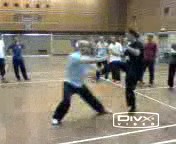MAKING VARIATIONS TO MEET CHANGING COMBAT SITUATIONS -- OVERVIEW

Course participants devised combat sequences from their selective sets to apply patterns in certain ways to gain certain advantages.
Would our combat sequences still be useful if our opponents do not use the techniques or fight in the order we have planned in our combat sequences? Yes, they are very useful, but we have to make adjustment. The adjustment can be at a technical level or at a sequential level.
At a technical level, suppose according to the sequence you are to execute a “Double Bows Tame Tiger” to counter the opponent's strike, but he attacks with a side kick instead of a thrust punch, you make an adjustment at this point. Instead of shifting your body backward for a “Double Bows”, you retreat you front leg and counter with “Lohan Strikes Drum”, then immediately you move forward with a “Double Bows” (even when he is not attacking with a thrust punch) and continue with your planned sequence.
At a sequential level, you respond with “Lohan Strike Drum”, then immediately continue with another sequence, where “Lohan Strike Drum” may be at the beginning or the middle of the new sequence, or it may not even be in the new sequence. In our sparring methodology, the technical adjustment corresponds to an “addition”, whereas the sequential adjustment corresponds to an “external change” or an “internal change”.
These terms and methods are for understanding and convenience of training. Once you are able to perform them, you need not worry about the steps or terms, you just respond spontaneously. The video clips in this series give an example of this developmental stage of composing combat sequences from selective sets involving a process called “variations”.
- Understanding Philosophy of Combat Situations
- Be Prepared for Deadly Counters
- Subduing a Dragon
- Variations from Standard Sequence
- Intercepting with Single Knife
- Counter with Organ-Seeking Kick
LINKS
